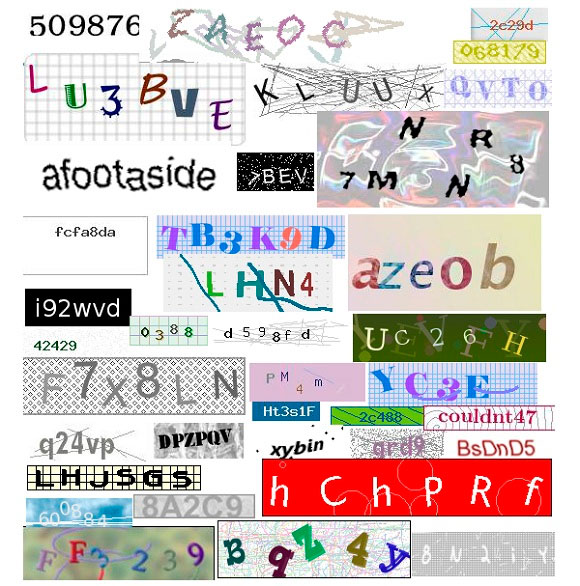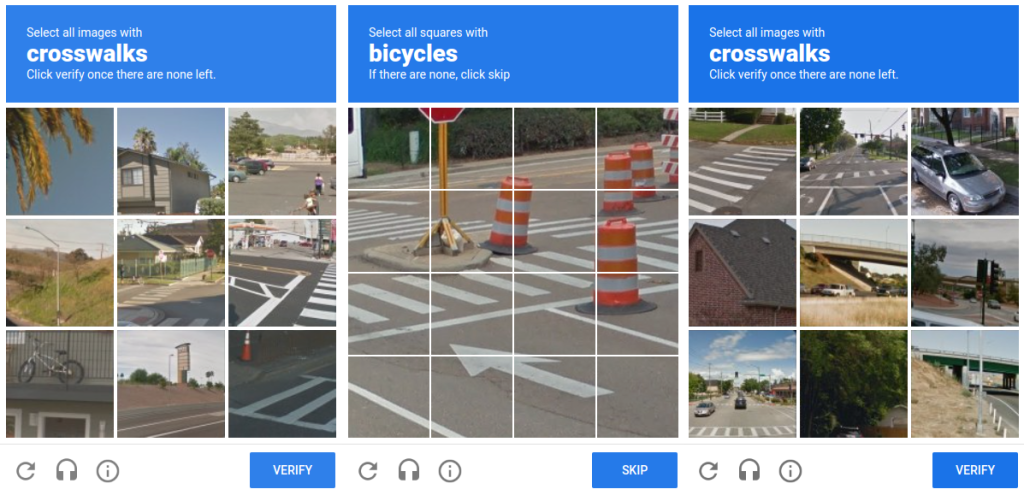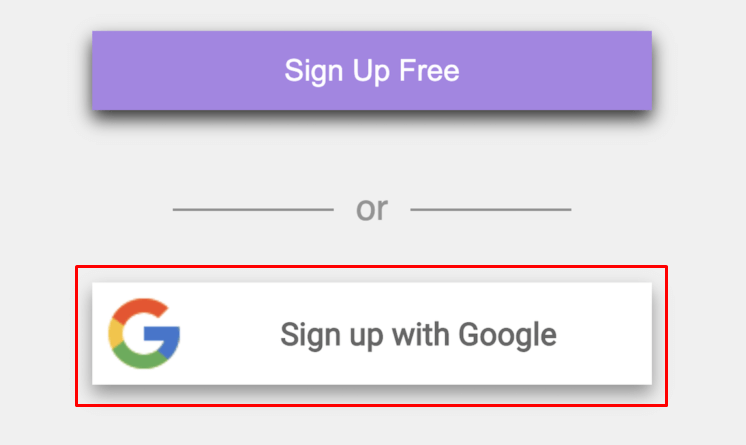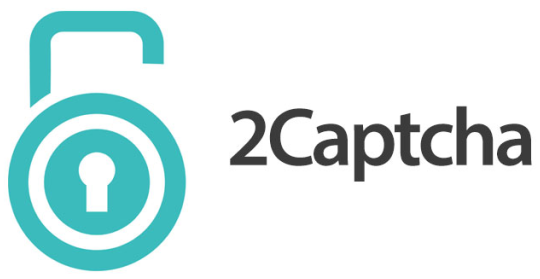
 en
en  Español
Español  中國人
中國人  Tiếng Việt
Tiếng Việt  Deutsch
Deutsch  Українська
Українська  Português
Português  Français
Français  भारतीय
भारतीय  Türkçe
Türkçe  한국인
한국인  Italiano
Italiano  Gaeilge
Gaeilge  اردو
اردو  Indonesia
Indonesia  Polski
Polski Google developed reCAPTCHA as a CAPTCHA system that attempts to tell if a web request is coming from a human being or a bot. It utilizes far more sophisticated algorithms than simple CAPTCHA verification forms for the analysis of user interactions. Before we dive into how to bypass reCAPTCHA, we need to make it clear what it is and how it works.
Yes, indeed, traditional CAPTCHAs focus exclusively on text challenges that require users to identify jumbled letters. Conversely, reCAPTCHA offers a more sophisticated solution on the modern relaying authentication framework by integrating image-based CAPTCHAs that utilize real-world visuals.
Here's how a standard CAPTCHA might look:

Typical reCAPTCHA example:

Check the box and tick. In some cases, confirmation pop-up windows appear. Such windows might look as follows after site access has been granted.

reCAPTCHA is designed to prevent automated software from abusing web resources and thus is considered a security feature for websites. Below are some of the ways that reCAPTCHA technology is integrated into web development:
reCAPTCHA is important in the World Wide Web, as it aids in the elimination of spam as well as automated activities like bulk feedback or comment submissions and fake account creation. It also helps prevent bot hacking attempts that compromise one's accounts, thereby protecting sensitive information. Important note. You cannot disable CAPTCHA at all but you can effectively bypass it. This article will focus on how to bypass reCAPTCHA and explore this technology further.
So, one can ask: why does Google keep asking if I'm a robot? A unique technique is employed by reCAPTCHA to check for any suspicious activities on a website. Such as how you interact with it by measuring the rate at which you fill in the form fields, mouse movements, time spent on a certain webpage, among many others. It also performs request rate statistical analysis as well as traffic analyses such as the IP of computers accessing the site.
Here’s a breakdown of how reCAPTCHA operates step-by-step:
reCAPTCHA has integrated algorithms based on machine learning to analyze responses to challenges and perform other statistical comparison analyses relative to the ongoing session, including juxtaposing it with previous sessions.
From analyzing the principles in the functioning of reCAPTCHA alongside the techniques employed in tracing dubious activities on a given site, a number of frequent triggers can be determined. These are fingerprints of a user with identifiable suspicious behavior, an abnormally high count of requests that, from a behavioral perspective, do not seem human, and observed active aggression towards the site. Understanding how it works can help you bypass reCAPTCHA.
A fingerprint is termed as a collection of identification features of a specific browser and the device hosting it. It encompasses the following parameters:
Upon each request, various types of HTTP headers are sent to the end server and are checked against security systems. Some of these headers include:
In the case where bots are used for automating actions on a particular site, the information captured in these headers tends to be incorrect, absent or poorly formatted, making the fingerprint highly suspicious.
Moreover, the security system of the site also studies the person’s geographical location on the basis of the IP assigned to them. In case this area does not correlate with a certain Internet provider or does not match the locations logged in earlier sessions, the site won't let you bypass reCAPTCHA. This technological solution also has the ability to detect IP addresses affiliated with other VPN services and possesses its own “blacklist” of some ranges of IPs. The presence of a CAPTCHA, as you will see, is fundamentally designed to deny access through anonymizers and protect from unauthorized access.
Traffic abuse comprises a variety of fraudulent attempts aimed at manipulating website statistics and disrupting the operation of the website. A couple of examples will illustrate traffic abuse:
These activities are often done as a means to exploit a resource for self-interest. For example, by rerouting traffic, offenders can surreptitiously capture data, which can later be used for malicious intents, thus maliciously impacting the website’s standing. Furthermore, the use of clickbots can deceptively increase the advertising revenue, either expending the website owner’s finances or unjustly profiting from false clicks.
reCAPTCHA solving mitigates such exploitation in an attempt to limit bot activity. This technology helps curb certain abuses of traffic and makes it harder to carry out automated assaults since bots or scripts invariably fail to identify and complete CAPTCHA tasks. It must be stressed that traffic abuse cannot solely rest on the shoulders of reCAPTCHA – other measures must be in conjunction with analyzing interaction data or deploying behavior-based intrusion detection systems to bolster defenses.
A website can initiate a variety of actions that could severely stress its resources by creating an excessive number of requests or asynchronous tasks. These activities include:
In these situations, to bypass reCAPTCHA, you need to limit the number of requests. By providing tasks that are hard for machines to circumvent, reCAPTCHA prevents further automated attempts, which decreases the number of requests and lessens the burden on the server.
reCAPTCHA technology has its own distinctive features, which provide multiple avenues of bypassing it, one of which is adjusting one’s digital fingerprint. Moreover, there are automated CAPTCHA-solving services that can be embedded into software to complete CAPTCHAs without human intervention. So, how to bypass CAPTCHA verification effectively? The most efficient strategies involve combining several approaches, technological and otherwise, to reduce detection and maintain unobstructed access to targeted web resources.
While using Google services such as Google Search, Google Scholar, or even YouTube, logging into a Google account provides simple methods of how to bypass reCAPTCHA. Google, for instance, implements a bot mitigation system using account data that a client has and the history of their interactions with the system. This technique is likely to work with other remote access services that accept Google credentials, as it relies on the user’s assumed trust associated with its services.

Yet another attempt to gain access to a web service will trigger reCAPTCHA as a security verification regardless of the user's authenticated state if there is a high volume of traffic submitted or any other unusual patterns present in the data. This guarantee is necessary to verify accuracy and to help strengthen the trust in a web resource.
There are two main ways on how to avoid CAPTCHA. It can be approached from various angles, both manually and automatically. One of the automated approaches is using software that interfaces with one's software, APIs for automating CAPTCHA solutions, and even plugins.
Unlike CAPTCHA services that range from entirely automatic to semi-manual, where AI is used with human verification checking, every service that equips the solving of automated CAPTCHAs comes with its own set of challenges. Undoubtedly the most known service dedicated to automated CAPTCHA bypassing is reCAPTCHA.

This service operates on the principle of manually solving and can address all current CAPTCHAs from Google, recognizing them on any website. The bypass reCAPTCHA function is facilitated through integration with the service's API.
In the 2CAPTCHA service, payment is based on the number of puzzles solved, with a rate of €1.00 per 1,000 recognized CAPTCHAs. According to the developers of the service, the average time to bypass a standard one is about 6 seconds.

DeathbyCAPTCHA can be integrated into web applications or software using an API. This service operates on a hybrid model combining OCR technology and manual human input for CAPTCHA solving. The developer states that the service achieves a solution accuracy of 90 percent and responds in an average time of 8 to 10 seconds. Additionally, there is a guarantee feature; when activated, a CAPTCHA task will be sent to three different workers to ensure the results are correct.
To remove reCAPTCHA, the current pricing of $2.89 per 1,000 correctly solved CAPTCHAs is considered high. It is, however, important to note that users are not charged for tasks that cannot be bypassed.

This service is based on artificial intelligence systems. AZCAPTCHA has more than 90% effectiveness solving reCAPTCHA. It has multiple plans, some of which offer unlimited CAPTCHA solving for a specific timeframe as part of the package. It also provides services for $1 per 1000 solved Google CAPTCHAs.
Moreover, AZCAPTCHA has extensions for Chrome and Firefox, which enable you to automate CAPTCHA solving while browsing the internet.
Since Google account login does not guarantee CAPTCHA skips on all sites, and a CAPTCHA-solving service only removes the CAPTCHA after backend systems detect it’s a solved pattern, employing anti-detect browsers and proxy servers could serve as better solutions to bypass reCAPTCHA.
Another way to skip CAPTCHA is to use anti-detect solutions. They are specifically designed to prevent tracking of a real user's data online. They are popular in SEO optimization, SMM marketing, e-commerce, and other fields where account creation and management from one workplace are crucial in multitasking.
These tools have advanced functionality designed to automate CAPTCHA interactions while minimizing the possibility of an account being flagged or banned:
There are five widespread anti-detection solutions that have thoughtful features for customization of one's digital footprint, as well as effective bypass reCAPTCHA strategies.

The browser features specialized tools for team collaboration, enabling the creation of numerous profiles with unique digital fingerprints for each. Additionally, it supports scripting directly within the interface to automate repetitive tasks, significantly reducing the need for routine manual input.
Dolphin {Anty} provides access to an extensive database of real fingerprints, greatly minimizing the likelihood of encountering CAPTCHAs. This feature helps prevent the linking of profiles that are created and managed within the same workspace, enhancing the effectiveness and security of operations conducted through the browser.

This anti-detect solution, along with other advantages, comes with a set of multilogin features aimed at achieving greater privacy and efficiency. One of the many features is a speedy generation of disposable profiles, which are defined as browser profiles that are deleted once and only when Multilogin is closed. These are useful for conducting excessive short-term activities.
Furthermore, it also boasts the ability to automatically turn off dangerous extensions that might leak the real personal data. For example, when a proxy is set, Multilogin automatically retrieves its parameters and sets corresponding values like the languages, the time zone, geolocation, and several others. Moreover, Multilogin has a “CookieRobot” that will go through pages and gather cookies, simplifying the process for the client.
These characteristics allow substantiating a digital fingerprint that can change the interaction with the system and help bypass reCAPTCHA, thus ensuring better and more secure browsing sessions.

GoLogin has a multitude of distinguishing characteristics, including a web variant that permits you to launch profiles on a cloud server and edit them, as well as an Android mobile application.
The browser includes the “Warpcore” function, which is particularly advantageous for collaboration. With this function, users can operate profiles on different versions of the Orbita and its corresponding engine versions. Warpcore guarantees uniformity across the browser core and mitigates issues where team members utilize different versions of GoLogin and Orbita. This uniformity helps prevent account detection, bypass reCAPTCHA, and prevent blocking of accounts. These features make Warpcore invaluable for sustaining seamless and secure team operations.

To bypass reCAPTCHA as much as possible, AdsPower provides some helpful features that assist in creating a more realistic fingerprint:
These features help in achieving more effective individual profile settings on the anti-detection browser, which assists greatly in bypassing CAPTCHAs, because, as we mentioned already, you cannot turn off CAPTCHA fully.

Designed for both a team and an individual, Incogniton comes with two pre-installed browsers: Sun Browser, which runs on Chromium, and Flower Browser, which runs on the Firefox engine. The browser includes a “Cookie Collector” tool that accepts limitless customization of cookie fingerprints.
A standout one is the integrated OCR feature. This allows users to capture images of text and edit the text, showing the advanced functionality and usefulness of the browser.
As with all anti-detect browsers, various capabilities come with varying tariff plans. Let’s look at these deeper through a comparative table.
A proxy server can help bypass reCAPTCHA by hiding the real IP when sending a request. This is particularly important for data scraping purposes or purchasing items from e-commerce websites. For these purposes, specialized software known as scrapers and sneaker bots is employed. While these programs operate, they make numerous requests to the end servers, which triggers reCAPTCHAs as a protective mechanism.
With proxy support within such software, one can bypass reCAPTCHA or at least minimize CAPTCHA's attention. However, it must be noted that qualitatively working proxies must have rotation – changing IP – or a pool of static servers. In this scenario, a proxy will not be overly monitored through one IP and therefore will not be flagged by the website's security system as suspicious. Thus, two main categories of such servers should be outlined: static and dynamic, followed by a detailed discussion.
As previously mentioned, they are assigned IPs that do not change unless altered by the user. They can be rotated manually via specialized software such as sneaker bots, anti-detect browsers, and scrapers. This process requires acquiring a block of IP addresses, having them loaded into the software, and setting a time interval for rotation.
This category includes the following:
Note: these two are not equally effective for bypassing CAPTCHAs, which is related to their origins.
The data center ones of type IPv4/IPv6 are assigned by various companies that own private data centers. They are only linked to a certain region, as they have no real ISP associations, making them absent from registries of IP addresses on the internet. During verification of such an IP, security systems check its validity along with its supposed provider and host. If these are unreachable, default CAPTCHA solving is required.
Compared to other types, ISPs have the advantage of being less likely to trigger CAPTCHAs since they are located on the ISP’s servers. That said, excessive request sending from a single IP would likely result in CAPTCHAs being triggered, as the volume of activity would not be typical for an ordinary user.
Rotating dynamic ones allow users to customize how dynamically assigned IP addresses are changed, such as time-based or per each new URL request. This proxy removes the bottleneck of having to purchase a pool of IP addresses, as buying a single one or a traffic plan provides access to a dynamically rotating pool of IPs.
This category includes two types:
Residential ones are those assigned to actual users whose devices are connected to the Internet. Because it is possible to establish the true provider, host, and geolocation of the device, these web resource security systems tend to trust residential ones more. The dynamic nature of the proxies also enables them to bypass the request limit set by web resources on a single IP address, thus lowering the chances of triggering CAPTCHAs.
Mobile ones utilize devices with SIM cards. In general, it helps bypass reCAPTCHA due to the way mobile networks operate:
NAT means Network Address Translation. It refers to a feature in mobile networks where a private computer network IP in a public domain is transformed or changed to a valid and accepted computer networking IP. NAT helps in the management of mobile broadband. It allows numerous devices employing the mobile network to make phone calls, to share a single mobile IP address, and to still make use of the private IP address system. This will increase the available IPv4 addresses, which indirectly prolongs their availability.
Because of this operational principle, large amounts of requests coming from a singular mobile IP address are treated as normal activity and are not flagged as suspicious by web security systems.
Therefore, mobile proxies come out as the most potent means for bypassing reCAPTCHA, especially for automated actions or for resources that are heavily guarded. They are best used in conjunction with anti-detect browsers, sneakerbots, and parsers since they do not require additional services for solving CAPTCHAs.
You’ll learn how to bypass reCAPTCHA using proven techniques that reduce triggering CAPTCHA challenges. Follow these practical steps closely.
CAPTCHA systems use honeypots – hidden traps to catch bots. These often appear as invisible form fields or fake page elements that bots mistakenly interact with. Never interact with hidden DOM elements. Instead, scan pages to identify these traps before scraping. Always respect robots.txt and website terms of service. Avoid using proxy IPs flagged for suspicious activity, and don’t scrape from public Wi-Fi networks that are prone to blacklists. Tools integrated with Proxy-Seller’s services can help you detect honeypots.
Setting realistic HTTP headers helps mimic genuine users. Fake headers like “python-requests/x.x” or “HeadlessChrome” immediately raise red flags. Avoid headers that are missing key fields such as Accept-Language or Connection. Use browser devtools to inspect headers from popular browsers. Save these header templates and cycle through them. Libraries like fake_useragent can assist with this in Python. This simple step is essential for a successful Google reCAPTCHA bypass.
To dodge fingerprinting, rotate key headers like User-Agent, Sec-Ch-Ua-Platform, Referer, Accept-Language, and Cookies. Yet, keep headers consistent within a session to avoid mismatch detection. Tools like Puppeteer-extra-plugin-stealth, Selenium with custom header injection, or Python’s requests session objects allow smooth header rotation. Rotating headers makes bot detection much harder, improving your chances of bypassing reCAPTCHA v3.
IP rotation is critical. You can use sticky sessions (same IP for multiple requests) or rotate proxies after every request/batch. Free proxies are unreliable. Premium residential proxies perform better – offering geo-targeting and clean IP reputations. Proxy-Seller provides over 20 million rotating residential IPs worldwide with geo-targeting. Their proxies support sticky sessions and request- and time-based rotation and offer SOCKS5 and HTTP(S) options. Proxy-Seller’s IP pools clear CAPTCHA triggers caused by static or datacenter IPs to ensure smoother scraping. Limit your requests per IP and concurrency to avoid rate limits.
Use headless browsers like Selenium, Puppeteer, or Playwright to run JavaScript-heavy pages and simulate user actions. These tools help bypass CAPTCHA types relying on JS challenges by simulating mouse movements, clicks, scrolling, typing delays, and network conditions. However, basic headless mode reveals automation via navigator.webdriver. Use stealth plugins such as Selenium Stealth or Puppeteer Stealth to hide these signs. Running realistic browser interactions allows effective Google reCAPTCHA bypass in dynamic environments.
Bots expose themselves via flags like navigator.webdriver or altered JavaScript APIs. Use plugins or custom scripts to hide or spoof these indicators. This includes faking browser plugins, languages, user media, WebGL, and canvas fingerprints. You can employ the Chrome DevTools Protocol (CDP) to overwrite these properties. This step is vital to bypass reCAPTCHA v3 without raising alarms.
Mimic human behavior by adding random mouse movements, scrolling at variable speeds, clicking with delays, and typing naturally. Randomize action sequences and intervals to avoid predictable patterns. Use exponential backoff when hitting CAPTCHAs or error responses. Running headless browsers to execute JS challenges further helps. Libraries like pyautogui or Robot Framework assist with input automation. Continuously log and analyze your behavior to keep improving your reCAPTCHA bypass success.
Proxy-Seller specializes in premium residential rotating proxies, aligning perfectly with all recommended bypass reCAPTCHA strategies.
Using Proxy-Seller is a practical and effective way to implement key IP rotation strategies critical to any Google reCAPTCHA bypass effort.
Avoid these common errors to improve your reCAPTCHA bypass:
| Mistake (Cause) | Fix (Solution) |
|---|---|
| Interacting with hidden inputs or DOM elements activates honeypots. | Fix this by scanning and ignoring hidden fields before scraping. |
| Using static or datacenter IP proxies can lead to blacklisting. | Switch to rotating residential proxies like those from Proxy-Seller. |
| Sending requests too fast without delays triggers CAPTCHA. | Implement realistic timing, random intervals, and exponential backoff methods. |
| Leaving default scraping library headers reveals bots. | Customize and randomize headers on each request. |
| Not executing JavaScript or ignoring JS-rendered content increases detection risk. | Use headless browsers capable of full JS. |
| Repeatedly failing CAPTCHA without a fallback causes blocked access. | Combine avoidance methods with on-demand solving only as a last resort. |
By avoiding these pitfalls and applying the steps above, you’ll master how to bypass reCAPTCHA and lower CAPTCHA encounter rates effectively.
If you want to bypass reCAPTCHA for the purpose of multi-accounting or scraping the web in an automated fashion, it often necessitates employing multiple techniques. The most sensible way of doing so is utilizing an anti-detect browser paired with dynamic proxies. This configuration makes it possible to spoof the entire digital fingerprint and emulate numerous users interacting with a web resource to bypass detection patterns associated with reCAPTCHA.
Comments: 0